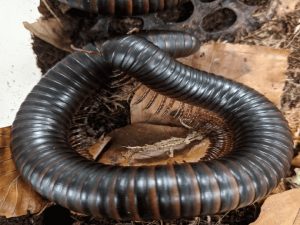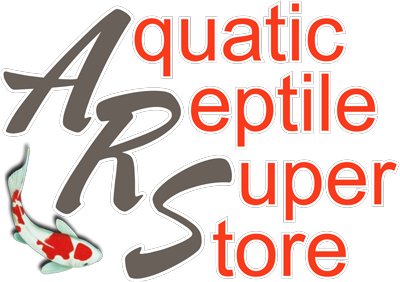African Giant Millipede
Archispirostreptus gigas

African Giant Millipedes are native to tropical and sub-tropical regions of Africa. They are a docile species and are easy to care for, making them an excellent pet for beginners.
They are also sometimes called Giant Train Millipedes, or “Shongololo” in the Zulu tongue.
All Millipedes are able to secrete a pungent fluid from their bodies as a defence mechanism. If this happens when you are handling your Millipede, be sure to wash your hands thoroughly and avoid touching your eyes and mouth. This liquid is usually harmless, but some people can have allergic reactions.
Latin Name: Archispirostreptus gigas
Difficulty Level: Beginner
Temperament: Docile
Life Span: 7 – 10 Years
Size: 13″ (33cm)
Habitat: Tropical and Sub-Tropical Forest floor, forested coastal regions.
Diet: Fruit, Leafy Greens, Veg, Rotting Wood, Leaves – Feed Daily.
Also feed with Bramble and Oak Leaves. These help with healthy exoskeleton growth.
Provide a shallow dish of fresh water. Don’t use tap water as Millipedes are very sensitive to chlorine.
Avoid feeding with Pine wood, and do not wash the Millipede’s food with tap water as it contains Chlorine.
Supplements: Calcium – Sprinkle Calcium powder on food or provide Cuttlefish bones.
Hours of Activity: Nocturnal – These Millipedes are most active at night time.
Handling: Handle as little as possible. Millipedes don’t like to be picked up and played with, and will secrete a foul smelling liquid onto your hands.
Temperature: Gradient of 24°C – 26.5°C (Heat mat at one end of the enclosure)
Humidity: 75% – 80%
Vivarium: 20 Litres (Minimum) – Glass or Plastic Box. It should be at least twice as long and twice as wide as the Millipede. Make sure there is a tight-fitting lid to prevent escape.
Substrate Type: Soil with Rotting Leaves. Make sure there is at least 2 inches of substrate.
Equipment Necessary: Enclosure, Heat Mat, Thermostat, Shallow Water Dish, Water Spray Bottle to mist the vivarium and keep it humid enough.
Cleaning Instructions: Spot clean any waste and uneaten food daily. Replace substrate entirely once per month.
Healthy Behaviours: Active at night, roaming the vivarium looking for its food. Eating well.
Sick Behaviours: Lethargy, not feeding, staying coiled up for longer than usual. This could mean the Millipede feels threatened.
Provide a means of escape from the water dish in case the Millipede falls in. This can be a stick or a stone.
If you find that the heat mat is drying out the substrate, you can affix it to the side of the vivarium instead of beneath it.
Be sure to keep the humidity levels adequate, both to avoid drying of the substrate and for the health of the Millipede.
If when handling the Millipede it secretes its terrible liquid onto your skin, be sure to wash your hands immediately. This juice is called “Repugnatorial Fluid” and is made of Hydrogen Cyanide. It is a brownish yellow colour, and will act as an irritant if it gets into your mouth or eyes.
These Millipedes can be kept in groups as they are docile herbivores and do not fight.
Millipedes do moult – Do not be alarmed by sudden inactivity, as this can mean the Millipede is about to shed its exoskeleton. Do not disturb the Millipede while it is moulting as any upset can be fatal due to stress and shock.
Common Problems:
Weak Exoskeleton – The Millipede isn’t getting enough calcium in its diet.
Fungal Infections – The Vivarium is either not humid enough, or too humid. Seek veterinary care urgently, change the substrate, and correct the humidity levels.
Mites – While some kinds of mites are often found on the Millipede, and can even be beneficial, there are also some kinds of parasitic mites.
The parasitic kind will latch onto the Millipede’s body, often around its head, and should be removed quickly but gently with tweezers.
Foot Rot – This happens when the humidity levels are consistently too high. It is caused by bacteria that attack the feet of your Millipede, reducing them to nubs.
The feet will grow back given time to heal. You must replace the substrate in the vivarium, and rinse off any objects within. This should remove the offending bacteria.
Being Dropped – These Millipedes are not adept climbers, so if you do handle it, be very careful not to drop it. Fall damage can seriously injure the Millipede if not outright kill it.
